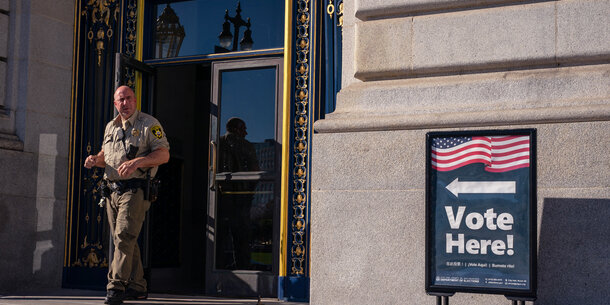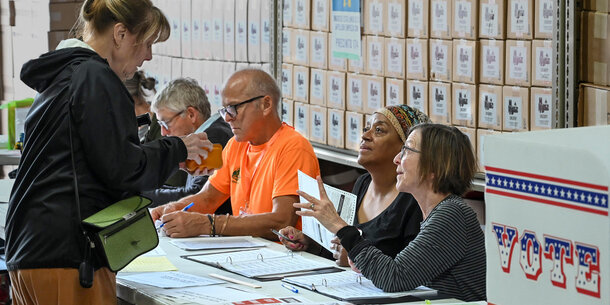This piece first appeared in Slate.
Six months after the 2020 election, the Arizona state Senate is conducting what it calls an “audit” of Maricopa County’s November results. The process has been roundly and rightly criticized as chaotic and partisan by election security and administration professionals—including members of the county’s own Board of Elections, which is not participating. Run by a company whose founder has spread Stop the Steal conspiracy theories, the audit has become an opportunity for people to peddle election-related disinformation. And these false narratives are too much for election officials in Arizona—or around the country—to combat on their own.
Social media platforms must take a more active role in preventing false information around elections from spreading and work with election officials to amplify accurate content.
The purpose of the sham in Maricopa County is to sow continued doubt in the legitimacy of President Biden’s election. Former President Trump claims the audit will somehow change results in Arizona, with other swing states to follow. It’s wholly lacking in the kinds of protocols and procedures you’d expect from a process intended to ensure rigor and accuracy—ballots have been left unattended, and a candidate for the Arizona House of Representatives who lost in November is one of the auditors. The conspiracy theories being investigated include ludicrous claims, one of which exploits anti-Asian racism: To inspect the ballots in an effort to legitimize the myth that they were fakes sent from China, workers used an ultraviolet light that could damage ballots, apparently to check them for bamboo fibers.
In fact, the official Twitter account for the audit is also proactively spreading false information. Interspersed with fundraising pleas, the account has tweeted information that’s not true about observers and reporters on site at the audit, as well as accusations of bias against local reporters who have exposed embarrassing flaws in the process. On May 2, a tweet from the account falsely accused one of the observers sent by Arizona Secretary of State Katie Hobbs’ office of sneaking his way into the event by pretending to be a member of the media, leading to calls that day on Twitter for Hobbs to be doxxed. Even after the call to dox the secretary was flagged for the platform, it was still available as of May 12. The president of the Arizona state Senate has also contributed to the problem, tweeting a false claim that members of the media had doxxed an auditor. On May 6, Hobbs revealed that her office had received at least three threats, including a call from a man who wanted to know what she was wearing so she would be “easy to get.” State troopers have been assigned to protect her.
Despite Trump and others being banned from Facebook and Twitter, social media remains an important vector for election-related disinformation. Far-right news sites pick up disinformation and then amplify and sensationalize it, further propagating it on social media: After the false information tweeted by the Arizona audit account and the state senate president, the Gateway Pundit published two articles pushing and expanding on these narratives. One reproduced a false tweet about the observer sent by Hobbs’ office and posted his image alongside that of a cartoon villain. The other accused a CNN reporter of harassing auditors. Although Gateway Pundit founder Jim Hoft, who ran the site’s Twitter account, was permanently banned from Twitter earlier this year, other users on the platform are spreading both articles on the platform.
Election-related misinformation is a widespread problem that election officials are trying to combat where they can. For example, Hobbs’ office has their own accounts where they share accurate information about elections or the audit. But the platforms need to take a bigger role in helping proactively combat these narratives, which have led to death threats.
Platforms could work with federal government partners to develop a directory of verified election officials, who they help in their efforts to inform the public about not just where and how to vote, but how their votes are counted. These election officials could benefit from amplification of their content when it otherwise complies with platform policies. That way, when Hobbs’s office provides accurate information about the audit, it wouldn’t be as easily drowned out by sensational falsehoods. Just as it makes sense to prominently display and promote content from trusted partners on issues of public health, like vaccines, it makes sense to build up those relationships with election officials and continue promoting correct information even after the election is over.
And requests from those same election officials to remove content for policy violations could also be prioritized for review—in particular content that harasses election workers or spreads false information about elections. If a call to dox a verified election official like Hobbs is reported, the platform could prioritize removing this content. Platforms have numerous reports of policy violations to contend with, but threats to election officials and workers exploded during the 2020 election cycle. The uptick is concerning not only as it relates to the safety of election officials and their families, but it has also raised questions among election officials as to whether they will be able to recruit and retain good staff to perform the job. The least the platforms can do for these heroes of democracy is respond to any harassment of them with extra attention.



